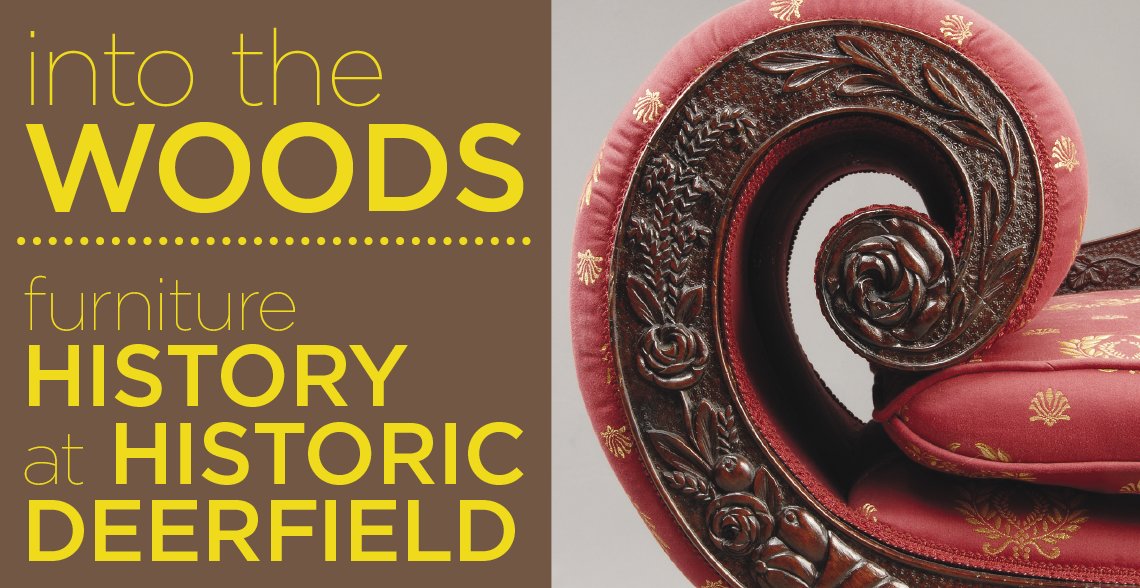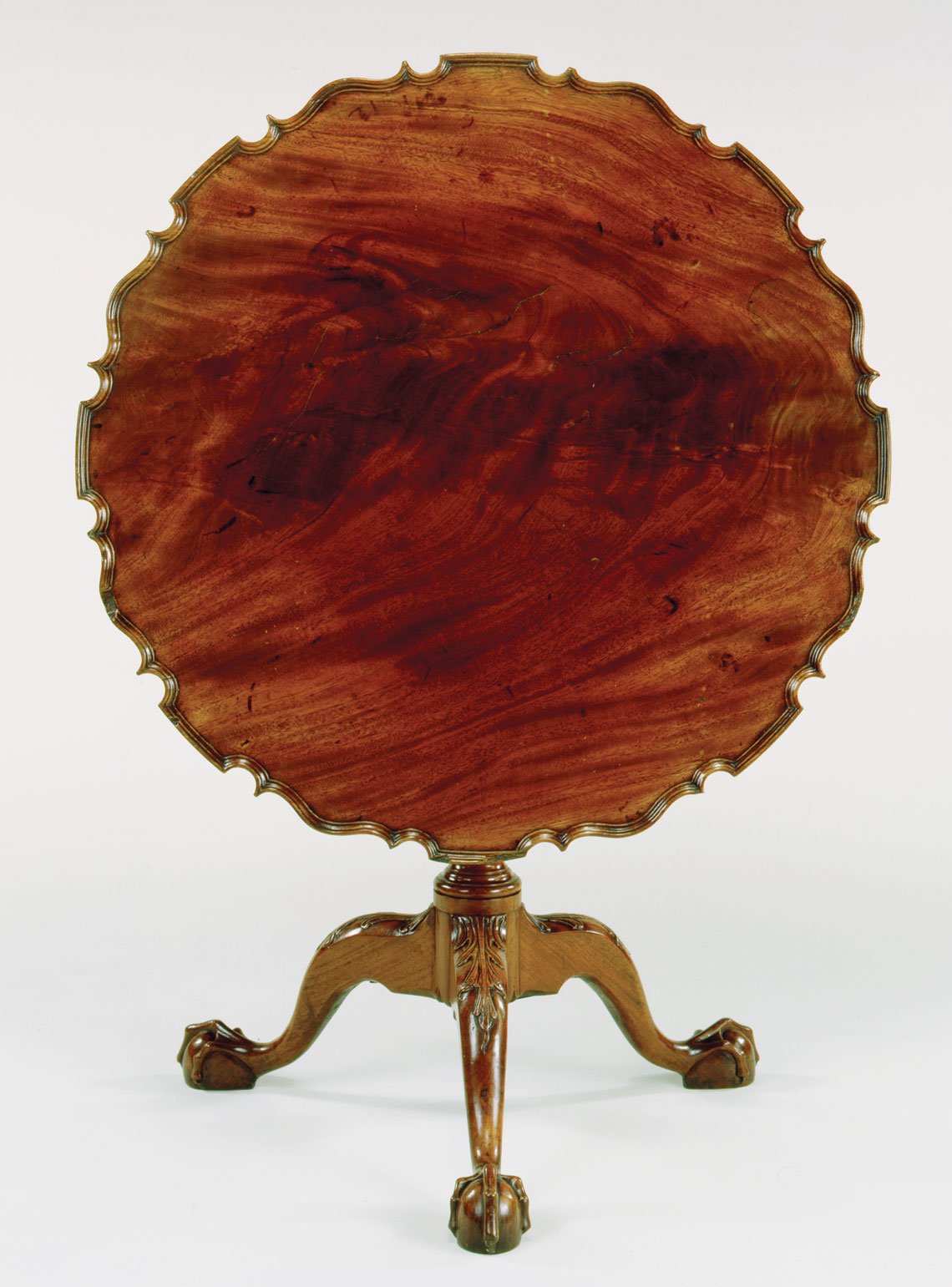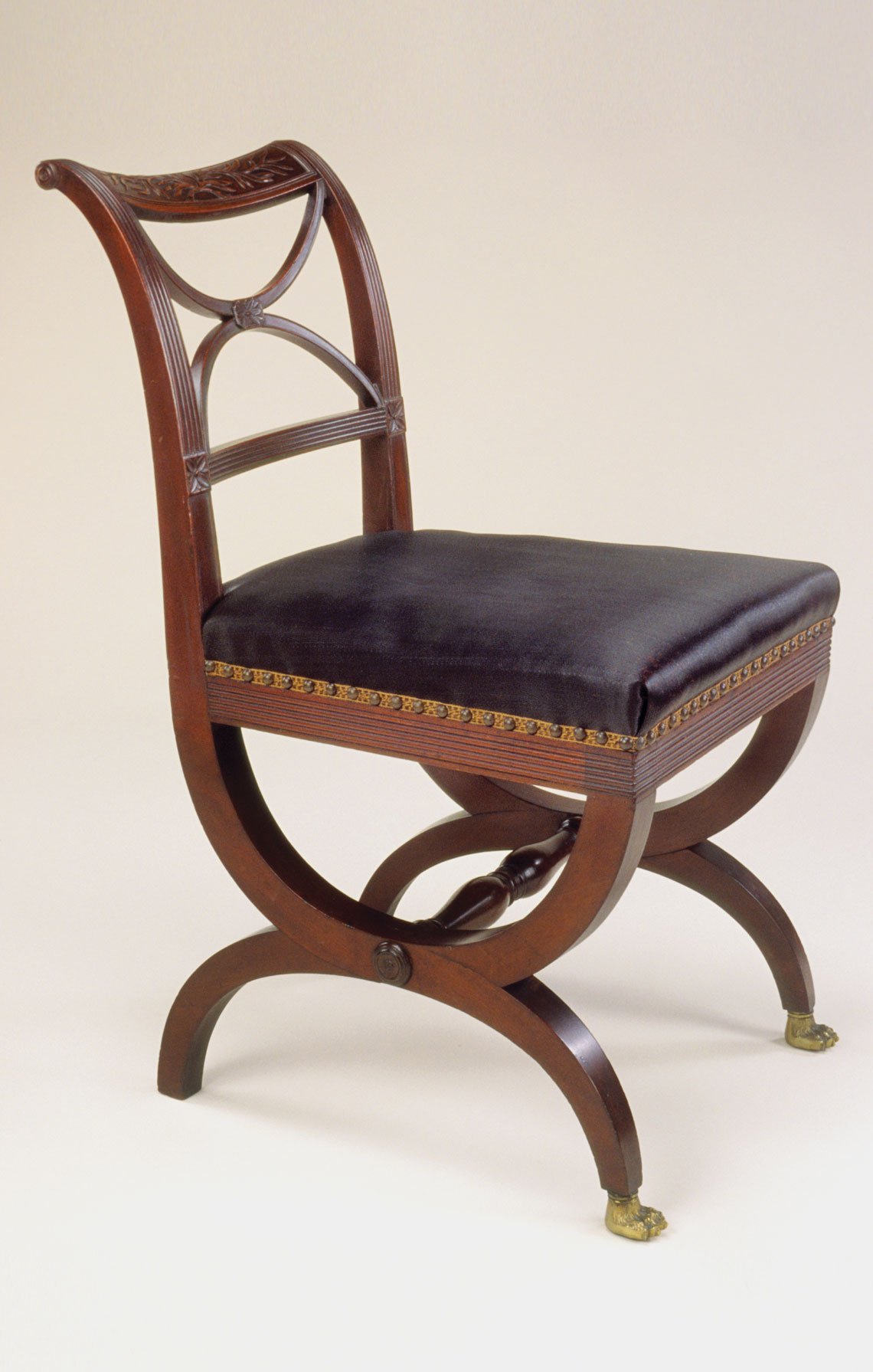Into the Woods Furniture History at Historic Deerfield by Joshua Lane
 |
by Joshua W. Lane
A new exhibition at Historic Deerfield brings a multidisciplinary perspective to early American furniture. Into the Woods: Crafting Early American Furniture explores the materials, techniques, and designs of sixty-five examples of case pieces, clocks, tables, seating furniture, and looking glasses dating from 1675 to 1825. The exhibition offers insight into changing tool technologies and labor practices; the rise of transatlantic markets for furniture design books, tropical hardwoods, and ingredients for varnishes; the innovation of specialized furniture forms; and the role of style in expressing changing notions of refinement.
Some of these topics are reflected in a joined chest with panel-ed lid that an Old Saybrook, Connecticut, joiner made between 1640 and 1680 (Fig. 1). The joiner constructed the chest entirely from red oak and white oak, both native to New England. Woodworkers considered the density of wood (today quantified as a measurement relative to the weight of water) as one of the most salient factors in choosing wood for furniture. Red oak and white oak are among the densest of woods used in early furniture, with specific gravities of .64 and .68, respectively. Heavy and tough to work when dry — attributes that made it an excellent choice for hard-wearing and durable furniture — oak had the major advantage of easy workability when unseasoned or tree-wet, with a moisture content upwards of 30 percent.
 |
Fig. 1: Chest with paneled lid, Old Saybrook, Conn., ca. 1640–1685. White oak, red oak, unidentified hardwoods. 2007.63. |
 |
Fig. 2: Chest with drawers, Hartford County, Conn., probably Wethersfield. Red oak, white oak, possibly eastern red cedar, maple, yellow pine. HD 63.76. |
 | |
Fig. 3: High chest, signed “Warham” (for Charles Warham or Wareham, [1701–1779]), Boston, Mass., ca. 1720. Soft maple, white pine. HD 56.152. |
To build the chest’s frame, the joiner used a marking gauge to indicate the size of the mortises and the tenons, and a narrow mortise chisel and a broad firming chisel to hollow and smooth the inside faces of the mortises. With a tenon saw, he cut the tenons, and using a brace and bit, he drilled separate sets of holes in each mortise and tenon. He forced long, flexible, tree-wet oaken pegs through the offset holes to draw each joint tight (creating “draw-bore” mortise and tenon joints). The wood shrank as it seasoned, further tightening the joint. As decorative as it was functional, the frame-and-panel lid reflected the original owner’s willingness to pay for the cost of cutting and fitting fourteen extra mortise and tenon joints, decorating the frame’s exterior edges with moldings, and dressing the panels. The current coat of brown paint covers an original layer of red ochre paint-stain.
One, or possibly several, Wethersfield, Connecticut, joiners made the expensively decorated chest with drawers (Fig. 2) around 1680 for a wealthy client. The joiner ran the applied moldings with a set of molding planes and scraped integral moldings on the frame members with a scratch stock, a flat metal blade with a shaped edge. Using long-handled gouges and chisels and a spring lathe, he, or a skilled turner, turned the hard maple half-columns and bosses, and using short-handled gouges, chisels, and a mallet, he carved the front panels out of tree-wet oak. He painted the lid, frame members, and panels red (red ocher, by microanalysis), the applied turnings and moldings black (carbon-based black, by microanalysis) to simulate African ebony, and the applied moldings surrounding the carved panels red with black striations to simulate snakewood, a West Indian hardwood with a pronounced figure that resembled snakeskin and that had only recently come into fashion in England. Although no tropical hardwoods were used in this chest, their simulated presence is evidence of a new taste for furniture decorated with expensive, exotic wood veneers that cut across geographical and class lines, found in the mansions of aristocratic Europeans and the parlors of colonial merchant-farmers by the last quarter of the seventeenth century.
 |  | |
| Fig. 4: High chest of drawers, probably Ipswich, Mass., ca. 1730–50. Walnut, walnut veneer, white pine. HD 1058. Right: Detail of figure 4. | ||
In the 1660s, England expanded its global trade in slaves and luxury consumer goods and developed markets for richly colored and figured tropical hardwoods such as African ebony, West Indian mahogany, and South American tulipwood and snakewood. Tropical hardwoods remained scarce and prohibitively expensive, prompting many English furniture makers to choose walnut — sourced from England, France, and North America (marketed as “Virginia walnut”) as an alternative.
Global trade brought other materials to bear in the furniture-making trades. From North Africa, English merchants imported sandarac, a fossilized tree resin, much like amber, that could be heated to the melting point and mixed with oils and thinners to make hard, clear furniture varnishes that saturated, protected, and enhanced these expensive woods. Along with lacquerwares from India and the Philippines, English merchants imported rattan for use in chair seats and backs. Cabinetmakers used these new materials to create dovetailed furniture that superseded frame-and-panel joined furniture. Now referred to as “baroque,” furniture in this new style was lighter, taller, and shinier than that of the previous generation.
A high chest that Boston cabinetmaker Charles Warham (1701–1779) made around 1720 illustrates his mastery of the new materials, tools, and skills required of baroque-style furniture (Fig. 3). Warham constructed the upper and lower cases and drawer fronts from soft maple, a wood with a specific gravity of .54, similar to that of walnut, and, with its fine grain, suitable for painting and gilding. To form the upper case, he smoothed the edges of two boards with a jointer plane and edge-glued them with animal-hide glue, melted in a double-boiler glue pot. With a dovetail marking gauge, dovetail saw, and a chisel, he dovetailed soft pine top and bottom boards to the sides, then smoothed the sides’ outside surfaces with a series of smoothing planes and scrapers. He dovetailed the soft maple drawer fronts to white pine sides and backs, taking care to orient the grain of each board in the same direction so that the joined pieces would react to changes in humidity at the same rate. He attached the turned legs to the lower case with round mortise and tenon joints.
 | |
Fig. 5: Tea table, Philadelphia, Penn., ca. 1770. Mahogany, walnut. In memory of Charles Warner Hurst and Julia Bates Hurst. HD 1999.5.2. |
When finished, Warham consigned the high chest to a japanner, a craftsman who specialized in reproducing the look of Asian lacquerwares. First, the japanner painted the backs of the drawers with Warham’s name to identify his work among pieces in his shop by other cabinetmakers. He coated the case sides, front, and drawer fronts with black paint, upon which he modeled figures and landscape features in low relief with gesso, a thin, plaster-like substance. After gilding the figures with gold leaf, and painting in details with bronze-powder paint, he sealed the finished work with four or more coats of varnish, polished to a high luster. Only the japanning on the upper case’s sides and drawer fronts and on the lower case’s two side drawers is original. The central drawer of the lower case, legs, stretchers, and feet are replacements.
As few colonists could afford the expense of japanning, most cabinetmakers decorated their best furniture with walnut veneer, inlay, and patterned cross-banding (inlaid borders) like that on an Ipswich, Massachusetts, high chest made around 1730 (Fig. 4). Two workmen used a large frame saw to cut sheets, or flitches, of veneer from a thick walnut slab. The cabinetmaker smoothed both sides of each flitch with a toothing plane (a short-bodied smoothing plane with a serrated blade), slathered both sides with glue and applied each flitch, reversing some to create a “bookmatched” effect. With a veneer hammer (a modified hammer with a wide head) he pressed the veneer into place and using the hammer as a squeegee, wiped away excess glue. With a scraper he removed glue remnants and smoothed the veneer.
 |  | |
Fig. 6; left: Dressing table, probably Northampton, Mass., ca. 1770. Cherry, white pine. HD 67.254. Fig. 7; right: Demilune commode, possibly by Stephen Badlam (1751–1815), Dorchester Lower Mills, Mass., 1795–1805. Mahogany, white pine, Spanish cedar. Gift of Mrs. J. Philip Walker. HD 85.019. | ||
One of this high chest’s most compelling design features, when new, was its cabriole legs — a design adopted by colonial cabinetmakers in the 1720s. To make the legs, the cabinetmaker first attached a solid walnut workpiece to a lathe and turned the pad foot. He used a template to outline the leg’s S-shape design on the workpiece, rough-sawed the shape and smoothed the leg with a drawknife, rasps, and a scraper. Although the ankles are only 1¼-inch in diameter, a controlled compression test of a replicated leg revealed that each ankle is able to carry upwards of a thousand pounds of pressure.
In the mid-eighteenth century, English lumber merchants negotiated with Spain for the right to cut mahogany in Spanish colonial territory (present-day Yucatan, Honduras and Belize) and supplied it to North American and European cabinetmakers eager to switch from walnut. With a specific gravity of .58, mahogany was only slightly denser than walnut and could be as readily worked. The surface of a circa-1770 Philadelphia tilt-top tea table demonstrates that mahogany owed its allure to its rich color and figure of the grain (Fig. 5). Made from a single mahogany board cut from a section of the trunk that encompassed the crotch of two branches, the top displays a pronounced “flame” figure. To create the top’s raised rim, the cabinetmaker attached the circular workpiece to a continuous-motion lathe’s faceplate and cut away the top’s surface with chisels and gouges. He then sawed and carved the rim’s pattern of molded points and curves.
 |
Fig. 8: Couch, possibly carved by Samuel Field McIntire (1780–1819), Salem, Mass., 1810–1815. Mahogany, birch, soft maple; textile (modern silk reproduction). Gift of Mrs. W. Scott Cluett. HD 92.014. |
 | |
Detail of Figure 8. |
Mahogany lumber required exposure to light and air for a year or longer to develop its color. This lengthy curing process necessitated investment not only in raw materials but also in storage space. Not all cabinetmakers could obtain mahogany or could afford the overhead involved in storing it. Instead, some cabinetmakers, such as those in the Connecticut River Valley of western Massachusetts, chose to make furniture from the heartwood of black cherry, a locally available, and less expensive, alternative, and only slightly softer than walnut and mahogany. A Northampton, Massachusetts, cabinetmaker took advantage of cherry to make a dressing table around 1765 (Fig. 6). Cherry heartwood’s attractive red-brown hue could be darkened with a brown-black stain, as in this example, to resemble the color of the costliest grade of mahogany; that which was harvested on the islands of Cuba and Santo Domingo.
Just as the Georgian style peaked, the neoclassical style was catching on. Neoclassical taste called for the overall redesign of furniture into geometric shapes such as rectangles and ellipses; the extensive use of veneer, often of contrasting colors and figures; and for the incorporation of classical motifs such as shields, urns, acanthus leaves, paterae (sunburst-like devices) and draped figures. A demilune commode (Fig. 7) that Boston cabinetmaker Stephen Badlam (1751–1815) probably made around 1805 was designed as a half-ellipse with three banks of drawers, probably adapted from George Hepplewhite’s The Cabinet-Maker and Upholsterer’s Guide (1788). He decorated the case and drawer fronts with stringing and inlaid half- and quarter-fans to evoke paterae. Badlam stacked boards to form wide horizontal laminates from which he cut the commode’s curved drawer fronts. In place of ebony, he used asphaltum, a blackened pitch, to fill in the voids at the ends of each ray in the fan inlays.
A neoclassical couch that a Salem cabinetmaker made about 1805 was embellished with relief-carved floral swags and cornucopia by Samuel Field McIntire (1780–1819) (Fig. 8). Inspired by the spirit of innovation, rural cabinetmaker Cotton White (1774–1826) of Hatfield, Massachusetts, experimented with local woods such as birch, maple, sumac, and with neoclassical designs to update Georgian-style furniture still popular in the countryside (Fig. 9).
 |  | |
Fig. 9; left: Desk and bookcase, possibly by Cotton White (1774–1826), Hatfield, Mass., ca. 1790. Cherry, white pine. HD 56.368. Fig. 10; right: Side chair with “Curule” (X-shaped) base, attributed to Duncan Phyfe (1768–1854), New York City, 1815–1830. Mahogany, mahogany veneer, cherry, white oak, and ash. Mrs. J. Philip (Cluett) Walker. HD 85.014 | ||
 |
Fig. 11: Pier table, with label of Charles-Honoré Lannuier (1779–1819), New York City, 1810–1815. Mahogany, mahogany veneers, tulip, poplar, and white pine. Gift of the estate of Mrs. W. Scott Cluett. HD 2003.21.31. |
As the neoclassical style matured, cabinetmakers designed seating furniture such as a New York City-made curule chair (referring to the X-shaped base), circa 1820, that closely approximated classical forms — in this case, a Roman curule chair (Fig. 10). They also used white marble and verdigris-hued paint (to imitate patinated bronze) to create new forms compatible with the classical style. A pier table with white marble top, verdigris-painted feet, gilt metal mounts cast in the form of reclining draped female figures and bearing the label of New York City cabinetmaker Jean Honoré Lannuier (1779–1819), resembled an altar (Fig. 11). In form and decoration, these classically-inspired objects appealed to consumers eager both to increase the comforts of home and to express moral and social values they admired in classical civilization and with which they sought to chart their own futures. Their recognition of furniture’s power to inspire resonated with later generations of collectors who refocused attention on early American furniture, laying the foundation for museum collections, including that of Historic Deerfield.
Joshua W. Lane is curator of furniture and coordinator of academic programs at Historic Deerfield. He curated Into the Woods: Crafting Early American Furniture, which will remain on view in Historic Deerfield’s Flynt Center of Early New England Life, Deerfield, Mass., through 2012.
This article was originally published in the Autumn/Winter 2008 issue of Antiques & Fine Art magazine, a fully digitized version of which is available at www.afamag.com. AFA is affiliated with Incollect.com.
 |



























